Sonchus palustris at Faxfleet
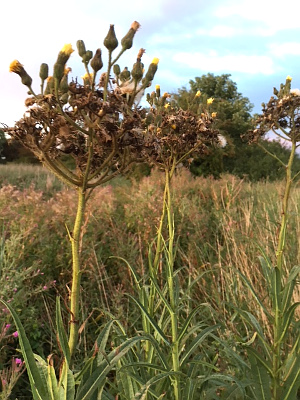 Sarah and Ken White have recently discovered a small colony of Sonchus palustris (Marsh Sowthistle) growing in a pond at Faxfleet. In the 19th century there was a colony at Brough (some of which was transplanted to East Park Hull) but this is the first confirmed record for vc61 for a century.
Sarah and Ken White have recently discovered a small colony of Sonchus palustris (Marsh Sowthistle) growing in a pond at Faxfleet. In the 19th century there was a colony at Brough (some of which was transplanted to East Park Hull) but this is the first confirmed record for vc61 for a century.
Photograph Sarah & Ken White, August 2018
TA41 - YNU visit to Kilnsea
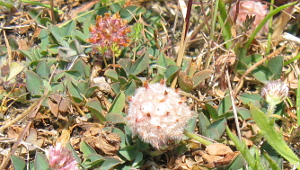 In view of the intense heat a somewhat relaxed approach was taken to the recording on Saturday when a small group strolled around looking at the "big picture". We were most impressed by the varied Atriplex garden (noted earlier by Peter) that has developed at the north west end of the recent breach to the peninsular. Here large quantities of mobile sand have been washed over what was previously rather rank vegetation. A luxuriant growth of fresh Atriplex littoralis, A. prostrata, A. laciniata and A. portulacoides now covers the area, along with seedlings of Salsola kali and other nice halophytes. The highlight of the afternoon followed a tip-off from Kate Wright who, that morning, had found Trifolium fragiferum near the pond area in Clubley’s field. We were rewarded not only with a fine display of Strawberry Clover(above) but also with abundant Juncus gerardii, Carex extensa and C. distans supported by occasional plants of Ranunculus sardous.
In view of the intense heat a somewhat relaxed approach was taken to the recording on Saturday when a small group strolled around looking at the "big picture". We were most impressed by the varied Atriplex garden (noted earlier by Peter) that has developed at the north west end of the recent breach to the peninsular. Here large quantities of mobile sand have been washed over what was previously rather rank vegetation. A luxuriant growth of fresh Atriplex littoralis, A. prostrata, A. laciniata and A. portulacoides now covers the area, along with seedlings of Salsola kali and other nice halophytes. The highlight of the afternoon followed a tip-off from Kate Wright who, that morning, had found Trifolium fragiferum near the pond area in Clubley’s field. We were rewarded not only with a fine display of Strawberry Clover(above) but also with abundant Juncus gerardii, Carex extensa and C. distans supported by occasional plants of Ranunculus sardous.
On Sunday Gabrielle and Helen were much more disciplined and collected a list of 116 taxa; a very creditable total considering the desiccated state of the vegetation after such a long, hot period.
Richard Middleton, 25 July 2018
TA41H - Kilnsea Warren
The shape of the Spurn peninsula South of the old buildings at The Warren (now dismantled except for the bungalow) is undergoing seasonal change due to coastal erosion and much of the fixed dune system on the East side of the road has gone leaving a cliff of only 1 m height at the edge of the road in places. There is only a sliver of sand of approximately 1 hectare remaining. At the breach, at Wyke Bite, sand is being washed through over what is left of the estuary saltmarsh creating a new beach. The road South of the 'round gun emplacement' has gone leaving a track that is daily traversed by 4x4 vehicles heading for Spurn Head when the breach is safe to cross. Available permanent foot-hold for vegetation is therefore very limited. On two evenings of 22 and 23 June I scoured this tiny fragment of tetrad TA41H and scored 73 significant taxa. The washed-through sand is supporting a luxuriant foredune atriplici with 4 Atriplex species including Frosted Orache Atriplex laciniata and also Prickly Saltwort Salsola kali, Sea Saltwort Honckenya peploides and Sea Rocket Cakile maritimum. This is a taste of the not too distant future. At the northern edge of the tetrad where buildings and concrete have been removed, very small plants of Lesser Swinecress Lepidium didymum were noted. At the current rate of erosion this whole tetrad will be sandy beach within the next 5 years.
Peter J Cook, 25 June 2018
TA31V - Spurn Head
Until today only the bulbous tip of Spurn Head South of the RNLI dwellings, including the complex of WWII military buildings, remained to be botanized for post 2000 records in hectad TA31. A total of 101 taxa included some significant updates from this remote and little-recorded corner of vc61. Access was a remarkable physical achievement for I walked about 10 miles on difficult terrain. Anyone proposing to go to the YNU weekend, 21/22 July, may not get this far unless you take transport on the UNIMOG. I am preparing notes on the location of some species-rich hot spots that I found higher up the peninsula for those of you not wishing to go that far. Watch your e-mail inboxes.
Peter J Cook, 27 June 2018
Carduus tenuiflorus
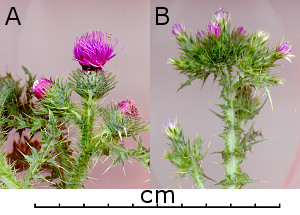 This year the Hull Natural History Society has been conducting a survey of 25 monads covering the Beverley area. Yesterday, while looking at TA0529 - Beverley Beck and NW Figham, Bill Dolling discovered an extensive colony of a pale, slender "Welted" thistle towards the northern edge of the common. Closer examination has confirmed this to be Carduus tenuiflorus, a taxon very rarely recorded in the vice-county.
This year the Hull Natural History Society has been conducting a survey of 25 monads covering the Beverley area. Yesterday, while looking at TA0529 - Beverley Beck and NW Figham, Bill Dolling discovered an extensive colony of a pale, slender "Welted" thistle towards the northern edge of the common. Closer examination has confirmed this to be Carduus tenuiflorus, a taxon very rarely recorded in the vice-county.
The above image shows a local Welted Thistle Carduus crispus (A) and Bill's appropriately named Slender Thistle Carduus tenuiflorus (B). Although the "welted" stems are superficially similar, the flowers are very clearly different. The narrow, pale, closely clustered capitula of C. tenuiflorus should make any future confusion unlikely. Now we know it's there I look forward to receiving lots of records ...
Richard Middleton, 15 June 2018
TA05D - Little Driffield and Keld
This location for the May Local Group meeting was chosen for its multiplicity of broad habitats including Elmswell Beck on the River Hull Headwaters SSSI, Britain's most northerly chalk stream. We were denied access to much of the stream and springs by recently erected barbed wire fences but we did get good views of Stream Water-crowfoot Ranunculus penicillatus subsp. pseudofluitans, in flower from a bridge. Sub-urban niches, cemetery, road verge, marshy pasture, ponds, some well maintained marsh, both wet and dry woodland and dry grassland yielded 214 taxa. Notable taxa included a Scaly Male-fern Dryopteris affinis agg., Brown Sedge Carex disticha and Carnation Sedge Carex panicea with its distinctive fruit already formed. Changing Forget-me-not Myosotis discolor that had not read the text books, and Marsh Marigold Caltha palustris that had, were pleasing to see. So often we see Caltha that had probably originated in a garden centre. Marsh Valerian Valeriana dioica and Bog Stitchwort Stellaria alsine were additional delights on a well managed marsh. Thread-leaved Water-crowfoot Ranunculus trichophyllus in both ponds affirmed old records for this species in TA05. Altogether this was a good day's work and play.
Peter J Cook, 16 May 2018
Fumaria parviflora - a posthumous identification
This note is more history than news and is published posthumously for Dr Eric Chicken. In May 2010, Eric wrote to me sending a sample of a fumitory that he had collected on waste ground at Kelleythorpe. It had small white flowers tinged with pink and minute irregularly serrate sepals. Identification had eluded Eric's expertise. Fumaria vaillantii was one of his suggestions, and was a very strong contender, but the extreme rarity of this species meant that we needed more material and referral for expert opinion. We agreed to agree that we would never identify it satisfactorily without mature fruit.
In August 2010 I collected some fruiting material from the same place but could not meet up with Eric on the same day, later finding that he had been admitted into hospital. I visited him on 23 August, and he passed away the following day. I subsequently forgot where I had put the specimen and gave no more thought to identifying the plant until Richard published his note about F. vaillantii in June last year. My pressed fell from between the pages of a book on 3 January 2018 and re-opened the debate again, albeit with myself.
The bracts were the same length as, or often longer than, the fruiting pedicel which very soon confirmed the identification as F. parviflora. However, what about the pink coloration? Stace (2ndEdition) comments that the flowers of F. parviflora are, "white or very pale pink". The fruits were the shape described for F. parviflora and contained well-formed seeds so hybridization was discounted.
Although not as rare as F. vaillantii, F. parviflora is listed in our vc61 Rare Plants Register and I think Eric would have been just as happy with this conclusion.
Peter J Cook, 3 January 2018
SE83Y – Houghton Wood/Moor
The stalwart six were joined by Gillian on this visit to 196 ha of largely inaccessible forested moor, the largest designated Local Wildlife Site in the East Riding. Houghton Moor has attracted the attention of botanists for two centuries but there has been no organised BSBI field excursion this century. Jurassic influence and Vale of York blown sand abutting chalk conspire to provide growing conditions for plant associations rarely encountered elsewhere in the East Riding. Our Rare Plants Register records more than a dozen taxa noted at Houghton including some that are now regarded as locally extinct. With one or more intentions of fun, updating our RPR or boosting our Atlas 2020 hectad totals, we advanced on a site clearly suffering from the longest drought for many years. However, it still yielded up sufficient taxa to push the hectad total to well over 600. Unfortunately we were unable to re-locate all of our 'target' rare species, but had a good time trying.
The first subject for debate was a population of 'atypical' Calamagrostis canescens, an apomict with known wide morphological variation. More typical C. canescens and C. epigeios were both found later. By early afternoon we still had not relocated Lemon-scented Fern but just as Richard set off to leave early, a joke shout, 'Oreopteris limbosperma', instantly turned into reality with a large population found along the top edge of a ditch. Blechnum spicant was another fern on the must-find list and was successfully relocated in several places including the bank of a ditch, the top edge of which bore an abundant carpet of Aira praecox mixed with Agrostis capillaris.
Species typical of marshy sand were found in vehicle ruts in several places and included Juncus bulbosus, both with and without bulbs and with adventitious growths from flowers. Some resembled Isolepis setacea in form and stimulated huddles and much page-turning. Luzula multiflora subsp. congesta occurred sporadically in ones and twos. Some additional 'star finds' were Carex demissa, Danthonia decumbens, Hypericum humifusum, Trifolium fragiferum, Samolus valerandi and Mentha arvensis. Another visit to record in SE83Z is planned.
Peter J Cook, 15 August 2018
Cirsium acaule - Beverley Westwood
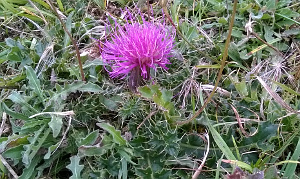
Richard Middleton, 27 August 2018
St Michael Community Woodland, Garton, TA2735
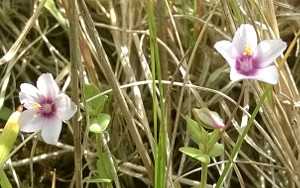 We met with the purpose of elevating the post-2000 score for the hectad with what we could find on a recently created community woodland developed over the gas storage facility by Scottish and Southern Energy and Statoil. We found the field layer already closed with naturally-occurring species appearing as singleton 'casuals' within expanses of Yorkshire Fog, commercial seed-mix fescues and rye-grasses. An interesting find was the blue, spreading meadow-grass Poa humilis, now Poa pratensis subspecies irrigata, which has hitherto been recorded as a denizen of the tops of old brick walls and very recently as a constituent of lawn turf. A large pond provided likelihood of adding some submerged and marginal species, which it did. However, we suspect that most of them had been planted. Discussion huddles were few but interesting, for example, as we looked at a pink form of Scarlet Pimpernel (above); at a single spike of Northern Marsh Orchid; critically examined Jointed Rush and compared Juncus effusus var. compactus with Juncus conglomeratus. St Michael produced marks but few sparks and at the point at which we started to compare and contrast natural variation in the stem colour of creeping thistles we thought it better to move on.
We met with the purpose of elevating the post-2000 score for the hectad with what we could find on a recently created community woodland developed over the gas storage facility by Scottish and Southern Energy and Statoil. We found the field layer already closed with naturally-occurring species appearing as singleton 'casuals' within expanses of Yorkshire Fog, commercial seed-mix fescues and rye-grasses. An interesting find was the blue, spreading meadow-grass Poa humilis, now Poa pratensis subspecies irrigata, which has hitherto been recorded as a denizen of the tops of old brick walls and very recently as a constituent of lawn turf. A large pond provided likelihood of adding some submerged and marginal species, which it did. However, we suspect that most of them had been planted. Discussion huddles were few but interesting, for example, as we looked at a pink form of Scarlet Pimpernel (above); at a single spike of Northern Marsh Orchid; critically examined Jointed Rush and compared Juncus effusus var. compactus with Juncus conglomeratus. St Michael produced marks but few sparks and at the point at which we started to compare and contrast natural variation in the stem colour of creeping thistles we thought it better to move on.
Acting on a tip-off that there are "hundreds" of Bee Orchids on the cliffs at Mappleton, TA24, we re-assembled there. Counts and estimates of Bee Orchids averaged 150 on the cliff slopes and slumps, the most that any of the five of us had ever seen in one locality. Northern Marsh and Common Spotted orchids were also noted, as were a single plant of Sea Sandwort Honkenya peploides and some Sand Couch Elytrigia juncea, which are post-2000 records for the hectad.
Peter J Cook, 20 June 2018
Rumex sanguineus var viridis vs.
R. conglomeratus explored
On several occasions friends have commented on my ability to identify Rumex sanguineus var viridis (Rsv) not yet flowering or fruiting and walk at the same time. Given that I now sometimes walk with a stick and have heard this comment once too often, I thought it time for me to explore whether I might be over-confident.
Starting with vc61 and national (BSBI maps), Rsv is being recorded evenly with no evidence of change in distribution, so there appears to be a high level of confidence among recorders that we are all correct (or all wrong!). In common with the national incidence, R. conglomeratus (Rc) appears to be declining locally, which is comforting evidence that we are getting this right too. It matches my own hunch from many BSBI Local Group and various surveys over recent years that Rc is not being seen as often as it used to, which coincidentally aligns with the observation of decline of freshwater wetland species generally.
Rsv is a plant which occurs commonly at the back of road verges and on ditch banks in the shade of hedges and in woodland margins. It prefers shade, hence Wood Dock. Early in life the leaves are yellowish green and with their adjacent branch lie not quite parallel with the stem, giving the plant a fastigiated stature even before the terminal flowering shoots take off.
Rc is a plant that grows in wetter places such as the bottom of shallow ditches and among Soft Rush in rush pastures (e.g. NVC MG10) and as a pond margin species. It prefers open, well-lit situations. The branches of Rc tend to be splayed at 45 to 60 degrees from the axis of the stem and the leaves are a darker shade of green than Rsv. Later in life the two species are easily differentiated by their tepal tubercles but in Rc, leaves running up to the apex of the plant appear to weigh it down making the whole plant straggly, spreading low and out of sight among pond marginal vegetation.
I have never seen the red veined var sanguineus outside a garden but Rsv does have traces of red at the base of petioles and the main stem. If the stem is broken off at soil level, red pigmentation can be seen over the full transverse section of the stem. This is not true for Rc and this is a useful, through destructive, field test.
Habitat (especially the shade preference), fastigiate stature and red pigmentation are, in order, the main vegetative features needed to distinguish Rsv from Rc at a walking pace before they fruit.
Peter J Cook, 17 May 2018
An inventory of native and exotic conifers
John Killingbeck has produced a survey of local coniferous and allied trees, based on observations going back several decades. It is an attempt to catalogue all the species likely to be encountered in vc61 and is intended to be a continuous process as new species are constantly turning up due to the widespread availability of novelties in garden centres. This extremely useful document may be downloaded here as a pdf file.
John would be interested to hear of any additions to the list.
TA16 - Urban Bridlington
On our first meeting of the Local Group in 2018, six of us visited the cemetery, a small wood and the streets lying within one monad in North Bridlington. Planned as a 'warm up', this was coincidentally the first really warm day of the year with several butterflies and humble bees on the wing. We scored 106 taxa, most of them mundane. Stinking Iris, Iris foetidissima, was found in the small wood. It is a plant of dry woods near the sea, mostly on calcareous soils according to Stace, so it raises the question whether it is natural or naturalized. It is an uncommon taxon in vc61. The same small wood contained mature planted Beech together with seedlings, which is an uncommon finding in SE Yorkshire. Small white crucifers were found in abundance, the most delightful of which, Erophila verna s.l, was sometimes the dominant species over several square metres. We had a pic-nic lunch behind a hedge and on departing spotted a single Spurge Laurel, Daphne laureola. The absence of old walls and water bodies in this monad is clear from the paucity of typical muraphytes and absence of aquatic and marginal species. Given the paucity of broad habitat in the monad and of mature plants early in a late season, our score was very good.
Peter J Cook, 14 April 2018
Asplenium marinum –
an unlikely success story?
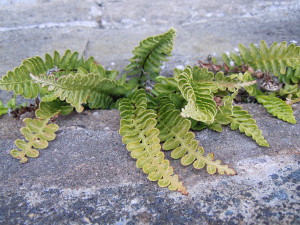 In 2004 Richard Middleton spotted a small clump of Asplenium marinum Sea spleenwort growing on the wall of the tidal basin, the lock separating the marina from the river Humber (BSBI News 98). It was a totally unexpected find. This evergreen, perennial fern, which grows on walls, cliffs and rock-crevices close to the sea, often sea-sprayed, is frequent on the coasts of the British Isles, except for the south and east coasts. What was it doing there and how did it get there? Would it survive? It could only have arrived on a boat. The Humber is tidal. Richard alerted the engineers to its presence and requested that they refrain from cleaning it off. He kept an eye on it and in 2014 introduced me along with the Hull Natural History Society to the taxon. At this point there were just a few plants.
In 2004 Richard Middleton spotted a small clump of Asplenium marinum Sea spleenwort growing on the wall of the tidal basin, the lock separating the marina from the river Humber (BSBI News 98). It was a totally unexpected find. This evergreen, perennial fern, which grows on walls, cliffs and rock-crevices close to the sea, often sea-sprayed, is frequent on the coasts of the British Isles, except for the south and east coasts. What was it doing there and how did it get there? Would it survive? It could only have arrived on a boat. The Humber is tidal. Richard alerted the engineers to its presence and requested that they refrain from cleaning it off. He kept an eye on it and in 2014 introduced me along with the Hull Natural History Society to the taxon. At this point there were just a few plants.
In 2017 the British Pteridological Society held their AGM in Hull and visited the site. Yvonne Goulding, ex-secretary of the BPS, and I independently decided to monitor the fern. On November 30th 2018 we teamed up with BPS assistance to count individual plants/clumps and look for evidence of regeneration. This is what we found:
In the shelter of the basin wall between TA 098281 and TA 099282 and growing about a foot down a total of 56 plants as follows:
TA 098281 2 plants/clumps and, separated by a small gap, 8 more plants, plus 4 small newer plants, pointing to regeneration
then 2 larger clumps.
TA 098282 25 plants, of which 9 seem to be regeneration.
TA 099281 5 plants
TA 099282 10 established plants at the corner of the basin.
Further evidence of regeneration: at TA 098282, but separated from the previously listed plants by a walkway, sheltered by a low wall behind the port authority control tower, a new plant alongside a single plant of A. adiantum-nigrum.
A total of 57 plants of A. marinum, the colony looks to be thriving, most of the new growth being fairly recent.
One qualification:
It is well known that A. marinum has a tolerance of sea-spray and needs protection from frost. The main body of the plants in the basin wall are exposed to air and spray from the tidal river Humber. This situation also affords protection both from frost and from pollution from nearby Castle Street. The new plant looks vigorous enough, and probably gets sprayed when boats pass through the lock, but is its situation too exposed? Will it survive?
Why has the colony done so well recently? Have milder, wetter winters played a role? What about other Aspleniums in the area?
In the immediate vicinity we found:
Marina: Asplenium trichomanes, A. scolopendrium, A. ruta-muraria and A. adiantum-nigrum with the latter being the most abundant by far.
Kildale Marine wall: as often happens, the wall had been cleaned off but plants were returning from spores in the crevices, including A. scolopendrium, A. adiantum-nigrum and, more abundantly, A. ruta-muraria.
Railway dock: impressive displays of A. scolopendrium, including one sport, also plants of the other three common Aspleniums, with largest clumps of A. trichomanes.
Old town: cluster of ferns on a well-known leaking drainpipe, including the only Polypodium encountered, but otherwise mainly A. adiantum-nigrum on tall buildings, seemingly increasing.
The (rare in VC61) colony of Asplenium marinum is healthy and increasing in the tidal basin, in the context of a presence in the area of thriving ferns of the Asplenium family.
Gabrielle Jarvis, 5 December 2018
SE64I – Heslington Tilmire
We have experienced adverse weather on our Local Group meetings but never a post-apocalyptic brown sandstorm borne on a gale-force wind, later driving horizontal face-stinging rain. We were hit by storm Ali and thought that if golfists on the adjacent course can bear suffering, so can we. We parked at Pool Bridge Farm fish ponds with thanks to Mr Steve Fletcher where we botanized his large carp pond and environs before heading North across the Common Land area of the Tilmire.
The drier southern part of the Tilmire was largely species-poor Holcus-Deschampsia and Holcus-Juncus 'carr' grassland but towards the lower NE end there was a mosaic of more mire-defining species. After the driest and hottest summer than experienced for many years it was difficult to discern clear vegetation associations from a strange mix of grasses and herbs. Nardus stricta, Molinia caerulea, Ranunculus flammula, Succisa pratensis, Danthonia decumbens and Eriophorum angustifolium each arose from a 'base sward' of Agrostis stolonifera and Potentilla anserina containing occasional Festuca ovina and Cynosurus cristatus. Dry, withered pieces of both Equisetum fluviatile and E. palustris indicated that areas should be much wetter. On the higher, sandier part by the FP running along the southern edge of the golf course there was Calluna vulgaris, Erica tetralix, Deschampsia flexuosa and Digitalis purpurea with Agrostis capillaris and some Molinia under birch. A 'star find' in this area was Senecio sylvatica alongside S. vulgaris providing an opportunity for comparison.
The list of species for the Tilmire, at 135, is good but a further visit after a wet Winter and Spring would be useful at least to elucidate the identity of an interesting sedge and look for several plants that are listed on the SSSI notification in 1990. To whet one's appetite is the alleged presence of the clubmoss Lycopodiella inundata. Areas of the golf course are also worthy of further investigation. The carp pond area yielded 65 species of plant, most of them on the bunds made from excavated soil.
Peter J Cook, 20 September 2018
Celery-leaved Buttercup occurring as a swarm in TA32D
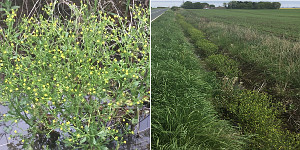 On May 12th I spotted Ranunculus sceleratus growing as a continuous ribbon for at least 50 metres along a roadside ditch near Withernsea that had been cleaned out about 2 years ago. I was surprised to see this species growing so robustly and occurring in such profusion to the extent that I returned armed with a camera.
On May 12th I spotted Ranunculus sceleratus growing as a continuous ribbon for at least 50 metres along a roadside ditch near Withernsea that had been cleaned out about 2 years ago. I was surprised to see this species growing so robustly and occurring in such profusion to the extent that I returned armed with a camera.
During our last 5 years of intensive recording I have no recall of seeing any more than a single plant and note that we have sightings from only about a half of the tetrads for which we have a record pre-2000. Given that this observation came as a surprise to me, I suspect that the species is in rapid decline across the Vice County.
Peter J Cook, 14 May 2018
Carnation Sedge (Carex panicea) in TA41
On 6th May I surveyed a small area of marsh on the berm of the Humber flood defence bank at Kilnsea (TA41D), which is now part of the new Kilnsea Wetlands reserve overseen by the Easington Biodiversity Study Group, headed by the Environment Agency. The marsh is at the eastern end of a borrow-pit that is notable for interesting species including Sea Rush (Juncus maritimus) and Distant Sedge (Carex distans). I chose a good time to visit for I found a strongly glaucous sedge with male spikes hanging heavy with pollen-shedding anthers. It was clearly not Glaucous Sedge (Carex flacca) and to my surprise I found it had leaves tapered to a trigonal point, the clinching vegetative field character that differentiates C. panicea from C. flacca and C. nigra.
At home I looked up C. panicea in Crackles' flora and was surprised to find a 'spot' for it in TA41C. There’s only one place in TA41C with habitat similar to Kilnsea Marsh so on 10 May, with obsessive-compulsive fervour, I headed down to the eastern end of Kilnsea Canal. Within a minute of setting foot there I found Carex panicea only a few metres from C. distans and Juncus maritimus. A mirror image!
C. panicea is not common in Holderness, though may be overlooked.
Peter J Cook, 10 May 2018
A Checklist & review of stonewort records
Peter Cook has produced a checklist and review of stonewort records for vc61 which is now available for download here.
It does not claim to be a comprehensive work, or to be a closed document, but it brings together records that have been published locally with some of those already mapped by the BSBI. The account includes examples of taxa that have re-appeared after a century of not being recorded and demonstrates that there is still plenty of scope for finding taxa apparently new to the vice county.
8 March 2018
 Sarah and Ken White have recently discovered a small colony of Sonchus palustris (Marsh Sowthistle) growing in a pond at Faxfleet. In the 19th century there was a colony at Brough (some of which was transplanted to East Park Hull) but this is the first confirmed record for vc61 for a century.
Sarah and Ken White have recently discovered a small colony of Sonchus palustris (Marsh Sowthistle) growing in a pond at Faxfleet. In the 19th century there was a colony at Brough (some of which was transplanted to East Park Hull) but this is the first confirmed record for vc61 for a century.
 In view of the intense heat a somewhat relaxed approach was taken to the recording on Saturday when a small group strolled around looking at the "big picture". We were most impressed by the varied Atriplex garden (noted earlier by Peter) that has developed at the north west end of the recent breach to the peninsular. Here large quantities of mobile sand have been washed over what was previously rather rank vegetation. A luxuriant growth of fresh Atriplex littoralis, A. prostrata, A. laciniata and A. portulacoides now covers the area, along with seedlings of Salsola kali and other nice halophytes. The highlight of the afternoon followed a tip-off from Kate Wright who, that morning, had found Trifolium fragiferum near the pond area in Clubley’s field. We were rewarded not only with a fine display of Strawberry Clover(above) but also with abundant Juncus gerardii, Carex extensa and C. distans supported by occasional plants of Ranunculus sardous.
In view of the intense heat a somewhat relaxed approach was taken to the recording on Saturday when a small group strolled around looking at the "big picture". We were most impressed by the varied Atriplex garden (noted earlier by Peter) that has developed at the north west end of the recent breach to the peninsular. Here large quantities of mobile sand have been washed over what was previously rather rank vegetation. A luxuriant growth of fresh Atriplex littoralis, A. prostrata, A. laciniata and A. portulacoides now covers the area, along with seedlings of Salsola kali and other nice halophytes. The highlight of the afternoon followed a tip-off from Kate Wright who, that morning, had found Trifolium fragiferum near the pond area in Clubley’s field. We were rewarded not only with a fine display of Strawberry Clover(above) but also with abundant Juncus gerardii, Carex extensa and C. distans supported by occasional plants of Ranunculus sardous. This year the Hull Natural History Society has been conducting a survey of 25 monads covering the Beverley area. Yesterday, while looking at TA0529 - Beverley Beck and NW Figham, Bill Dolling discovered an extensive colony of a pale, slender "Welted" thistle towards the northern edge of the common. Closer examination has confirmed this to be Carduus tenuiflorus, a taxon very rarely recorded in the vice-county.
This year the Hull Natural History Society has been conducting a survey of 25 monads covering the Beverley area. Yesterday, while looking at TA0529 - Beverley Beck and NW Figham, Bill Dolling discovered an extensive colony of a pale, slender "Welted" thistle towards the northern edge of the common. Closer examination has confirmed this to be Carduus tenuiflorus, a taxon very rarely recorded in the vice-county.
 We met with the purpose of elevating the post-2000 score for the hectad with what we could find on a recently created community woodland developed over the gas storage facility by Scottish and Southern Energy and Statoil. We found the field layer already closed with naturally-occurring species appearing as singleton 'casuals' within expanses of Yorkshire Fog, commercial seed-mix fescues and rye-grasses. An interesting find was the blue, spreading meadow-grass Poa humilis, now Poa pratensis subspecies irrigata, which has hitherto been recorded as a denizen of the tops of old brick walls and very recently as a constituent of lawn turf. A large pond provided likelihood of adding some submerged and marginal species, which it did. However, we suspect that most of them had been planted. Discussion huddles were few but interesting, for example, as we looked at a pink form of Scarlet Pimpernel (above); at a single spike of Northern Marsh Orchid; critically examined Jointed Rush and compared Juncus effusus var. compactus with Juncus conglomeratus. St Michael produced marks but few sparks and at the point at which we started to compare and contrast natural variation in the stem colour of creeping thistles we thought it better to move on.
We met with the purpose of elevating the post-2000 score for the hectad with what we could find on a recently created community woodland developed over the gas storage facility by Scottish and Southern Energy and Statoil. We found the field layer already closed with naturally-occurring species appearing as singleton 'casuals' within expanses of Yorkshire Fog, commercial seed-mix fescues and rye-grasses. An interesting find was the blue, spreading meadow-grass Poa humilis, now Poa pratensis subspecies irrigata, which has hitherto been recorded as a denizen of the tops of old brick walls and very recently as a constituent of lawn turf. A large pond provided likelihood of adding some submerged and marginal species, which it did. However, we suspect that most of them had been planted. Discussion huddles were few but interesting, for example, as we looked at a pink form of Scarlet Pimpernel (above); at a single spike of Northern Marsh Orchid; critically examined Jointed Rush and compared Juncus effusus var. compactus with Juncus conglomeratus. St Michael produced marks but few sparks and at the point at which we started to compare and contrast natural variation in the stem colour of creeping thistles we thought it better to move on.  In 2004 Richard Middleton spotted a small clump of Asplenium marinum Sea spleenwort growing on the wall of the tidal basin, the lock separating the marina from the river Humber (BSBI News 98). It was a totally unexpected find. This evergreen, perennial fern, which grows on walls, cliffs and rock-crevices close to the sea, often sea-sprayed, is frequent on the coasts of the British Isles, except for the south and east coasts. What was it doing there and how did it get there? Would it survive? It could only have arrived on a boat. The Humber is tidal. Richard alerted the engineers to its presence and requested that they refrain from cleaning it off. He kept an eye on it and in 2014 introduced me along with the Hull Natural History Society to the taxon. At this point there were just a few plants.
In 2004 Richard Middleton spotted a small clump of Asplenium marinum Sea spleenwort growing on the wall of the tidal basin, the lock separating the marina from the river Humber (BSBI News 98). It was a totally unexpected find. This evergreen, perennial fern, which grows on walls, cliffs and rock-crevices close to the sea, often sea-sprayed, is frequent on the coasts of the British Isles, except for the south and east coasts. What was it doing there and how did it get there? Would it survive? It could only have arrived on a boat. The Humber is tidal. Richard alerted the engineers to its presence and requested that they refrain from cleaning it off. He kept an eye on it and in 2014 introduced me along with the Hull Natural History Society to the taxon. At this point there were just a few plants. On May 12th I spotted Ranunculus sceleratus growing as a continuous ribbon for at least 50 metres along a roadside ditch near Withernsea that had been cleaned out about 2 years ago. I was surprised to see this species growing so robustly and occurring in such profusion to the extent that I returned armed with a camera.
On May 12th I spotted Ranunculus sceleratus growing as a continuous ribbon for at least 50 metres along a roadside ditch near Withernsea that had been cleaned out about 2 years ago. I was surprised to see this species growing so robustly and occurring in such profusion to the extent that I returned armed with a camera.